



Woodbridge Historic Sign
Corner of Amboy Ave. and North Park Dr.
In front of Denis B. Sullivan Park
Map / Directions to the Woodbridge George Washington Historic Sign
Map Directions to all Woodbridge Revolutionary War Sites
Woodbridge and its citizens were touched by events throughout the Revolutionary War era. This historic sign in the center of Woodbridge commemorates two of these events: one at the early stages of the War, and the other after the War had been won and Washington had been elected the new country's first President.
George Washington and his army suffered defeats during most of the year 1776, culminating in a retreat in November from Fort Lee across New Jersey. For the part of their retreat that went from Newark to New Brunswick, Washington's army moved in two columns, one of which came through Woodbridge, while the other went through Springfield, Scotch Plains, and Piscataway. [1]
Thirteen years later, the situation was very different. The Revolutionary War had been won, the Constitution had been written and ratified, and George Washington had been elected the first President. On his way to being inaugurated in New York City, which was then the national capital, Washington stopped in Woodbridge on April 22, 1789, and lodged at the Cross Keys Tavern. The Cross Keys Tavern is the subject of the bottom two listings on this page.




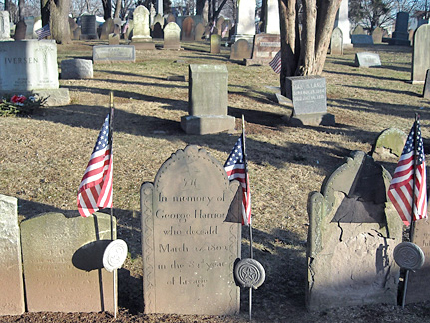

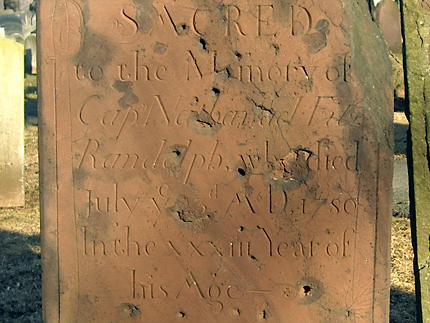
First Presbyterian Church of Woodbridge
600 Rahway Ave.
Map / Directions to the First Presbyterian Church of Woodbridge
Map Directions to all Woodbridge Revolutionary War Sites
www.oldwhitechurch.org
During the Revolutionary War, the pastor of the church was Reverend Azel Roe, who preached independence from his pulpit. He participated in a skirmish in what is now Carteret. He was later captured by the British and held prisoner at the Sugar Hill Prison in New York City. [2] Reverend Azel Roe and his wife Hannah are buried in the church's cemetery.
The original church building, which stood here during the Revolutionary War, was replaced by the current building in 1803. Revolutionary War veteran Jonathan Freeman was the architect and builder of this current church structure; he is also buried in the church's cemetery. [3]
The cemetery contains the graves of many Revolutionary War soldiers. The most interesting gravestone is that of Captain Nathaniel Fitz Randolph, who died of wounds he suffered at the Battle of Springfield. It is believed that the marks on his tombstone (clearly visible in the photo above, in the bottom row right) were made by British soldiers or local Loyalists who shot musket balls at the tombstone. The following is a list of Revolutionary War soldiers known to be buried here: [4]
John Adams
Died 1794
Thomas Alston
Died September 9, 1830 - Age 72 years
Captain Ellis Barron
1736 - May 27, 1807
John Barron
1760 - February 26, 1836
Alston Bishop
Died August 28, 1816
John Bishop
Died April 14, 1779
Jonathan Bloomfield
Died April 1, 1810, age 74
Doctor Moses Bloomfield
December 4, 1729 - August 14 1791
His house still stands in Woodbridge.
See entry lower on this page
Thomas Bloomfield
1752 - September 7, 1830
Timothy S. Brewster
Died February 6, 1837
Colonel Benjamin A. Brown
1764 - January 4, 1838
James Brown
Died July 25, 1831
John Brown
1751 - January 15, 1828
Thomas Brown
Died October 28, 1781
William Brown
1749 - March 31,1782
Jeremiah Clarkson
Died 1813
John Clarkson
1745 - August 1 1801
Randolph Clarkson
1752 - March 23, 1833
Enoc Coddington
Died November 1803
James Coddington
1755 - March 2, 1816
John Coddington
Died 1803
Joseph Coddington
Died April 30, 1806, age 51
Robert Coddington
Died August 15, 1833, Age 72
Captain William Coddington
Died 1845
Captain Samuel Crow
Died 1822
Colonel Samuel Crow
1741 - March 15, 1801
Edward Crowell
1759 - 1800
Joseph Crowell
1760 - March 18, 1834
Campyon Cutter
Died April 28, 1832
John Cutter
Died 1801
Kelsey Cutter
1750 - March 7, 1798
Samuel Cutter
1761 - May 1, 1805
Stephan (Steven) Cutter
1747 - June 20, 1823
William Cutter
Died February 14, 1780, age 57
Samuel Dally
Died March 11, 1784, age 51
Samuel Dunn
Died Jan 17, 1824
General Clarkson Edgar
June 21, 1756 - July 21, 1816
Captain David Edgar
1750 - September 6, 1810
James Edgar
1748 - January 8, 1815
Captain Peter Edgar
Died December 28, 1831
Thomas Edgar
1746 - July 31, 1812
Captain Peter Edgar
Died December 28, 1831
Henry Force
Died August 18 1777, Aged 57
Thomas Force
Died May 21 1783, (Aged 39)
Henry Freeman
1717 - July 16, 1784
Henry Freeman
1760 - March 7, 1838
Jonathan Freeman
August 10, 1763 - November 10, 1843
Revolutionary War Soldier
and
architect / builder of this church - 1803
Thomas Freeman
Died 1801
Richard Gibson
August 20, 1824
Thomas Hadden Sr.
1736 - September, 1784
Thomas Hadden Jr.
1760 - July 30, 1803
George Harriot
Died March 24 1802, Age 81
Brigadier General Nathaniel Heard
1730-1792
Arrested royal governor William Franklin
Samuel Heard
Died December 7, 1810, Age 63
John Inslee
1746 - April 23, 1791
Jonathan Inslee
1716 - February 24, 1777
William Jones
Died April 6, 1839, Age 84
Robert Lackey
Died August 17, 1824
Jeremiah Manning
1756 - June 10, 1803
John Manning
1755 - August 22, 1832
Captain Christopher Marsh
1742 - October 26, 1810
Ephraim Marsh
Died 1817
David Martin
1760 - February 13, 1808
William Martin
1756 - August 6, 1824
Daniel Moores
1728 - April 28, 1792
John Noe
1722 - March 20, 1796
Peter Noe
Died September 2, 1819, Aged 69 years
Lt. James Paton
1758 - November 6, 1816
Reuben Potter
Died March 25, 1799, Age 82
Nathaniel Fitz Randolph
Died July 23, 1780, age 22
Reverend Azel Roe
March 20, 1738 - December 1, 1815
Captain Matthias Sayres
Died 1817
William Smith
Died 1797
Samuel Stone
Died 1780
William Stone
Died 1797 / or 1788
Captain Abraham Tappen
Died September 29, 1799, Age 42



Trinity Episcopal Church
650 Rahway Ave.
Map / Directions to the Trinity Episcopal Church
Map Directions to all Woodbridge Revolutionary War Sites
Church office is generally open 9 am - noon; Tuesday - Friday, to view the Revolutionary War artifacts.
Call first to make sure they are open: 732-634-7422
What became known as Episcopalian Churches in America after the Revolutionary War, were originally Anglican Churches, or "Church of England." Due to their connection with the British, these churches, including this one, were ordered closed in New Jersey during the Revolutionary War. Despite this, it is believed that many members of this congregation fought for Independence on the American side during the war.
British troops occupied Woodbridge from December 2, 1776 to June 22, 1777. Some British soldiers are believed to have been quartered on the Church's property, with the Church serving as a barracks. That church structure was destroyed by fire in 1858, and the current church building was built in 1860/1861. [5]
Inside the church, there are several Revolutionary War artifacts on display in a case.
There is the grave of at least one Revolutionary War soldier in the cemetery, Private Asher Dunham (July 15, 1744 - August 20, 1803), whose original gravestone has broken and fallen over. A modern marker has been placed in front of the broken original tombstone. [6]


Jonathan Dunham House
650 Rahway Ave.
(Now used as the Rectory by the Trinity Episcopal Church)
Map / Directions to the Jonathan Dunham House
Map Directions to all Woodbridge Revolutionary War Sites
Built circa 1670-1700, this is the oldest building in Woodbridge and one of the oldest in Middlesex County. It was originally the home of Jonathan Dunham, who operated the first gristmill in New Jersey. The mill was located where Port Reading Road crosses the Woodbridge River. A millstone used in Dunham's gristmill is on display in front of the house.
The building was used as a garrison by American soldiers during the Revolutionary War.
This was originally a two-story, four room home. In 1870, additions were made to both stories, which more than doubled the building's size. The house was deeded to the Trinity Episcopal Church in 1873, who have used it as their rectory since then. [7]


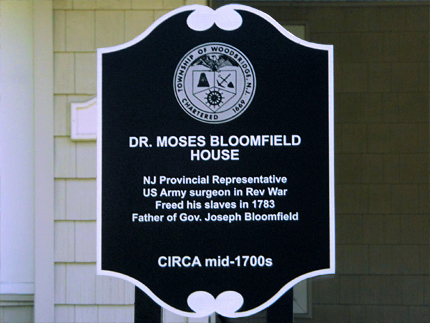
Dr. Moses Bloomfield House
117 Harrell Ave.
Map / Directions to the Dr. Moses Bloomfield House
Map Directions to all Woodbridge Revolutionary War Sites
This house is a private residence.
Please respect the privacy and property of the owners.
This house was built circa 1750. It was the home of Dr. Moses Bloomfield, who served as a surgeon in Washington's Continental Army during the Revolutionary War. He served as a Middlesex County delegate, at the time when the Convention of New Jersey adopted the state's first Constitution in 1776.
The Bloomfield house was damaged in 1777 during the Revolutionary War. Afterwards, the Bloomfield family fled from this house; they returned to it during the latter years of the war. The first anti-slavery meeting in Middlesex County is believed to have occurred at this house. Dr. Moses Bloomfield is reported to have freed his own slaves in a public declaration on July 4, 1783. Dr. Bloomfield died in 1791, and he is buried in the First Presbyterian Church Cemetery. (See entry above on this page)
Dr. Moses Bloomfield's son Joseph, who was born in this house in 1753, served in the Third New Jersey Regiment in the Revolutionary War. After the war, he served as New Jersey Attorney General and then Governor of New Jersey. The town of Bloomfield was named in his honor. Joseph Bloomfield is buried in the St. Mary's Church Cemetery in Burlington.
The Bloomfield House was originally located on Freeman Street and was later moved to this location. [8]



Aaron Dunn Homestead
12 Freeman St.
Map / Directions to the Aaron Dunn Homestead
Map Directions to all Woodbridge Revolutionary War Sites
This house is a private residence.
Please respect the privacy and property of the owners.
The Aaron Dunn house was built circa 1685, making it one of the oldest buildings in Woodbridge. Although the home bears the name of one of its original owners, it was called home by many before him. It may have been built as a manse for Archibald Riddell, the first minister of the First Presbyterian Church. This house was later owned by a Revolutionary War soldier named Aaron Dunn.
This is a very attractive and interesting looking house. Woodbridge Township Historic Preservation Commission has written the following about the house and its architecture: "The home contains many original features, including four fire places, and two sets of stairways to the second floor and the attic. Many of the doors are believed to be original to the home, fashioned in 'Christian style' with a cross shape between the door panels and fastened with "H" and "L" hinges. It is one of the best examples of early Colonial architecture still standing in Woodbridge." [9]

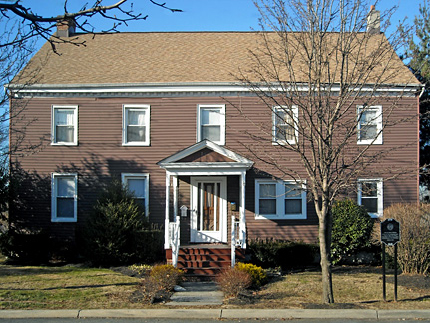

Cross Keys Tavern
142 James St.
Map / Directions to the Cross Keys Tavern
Map Directions to all Woodbridge Revolutionary War Sites
This house is a private residence.
Please respect the privacy and property of the owners.
In April of 1789, George Washington traveled from his home in Virginia to be inaugurated as the country's first President in New York City, which then served as the national capital. Traveling north from Virginia, he reached New Jersey on April 21 at Trenton, where he was greeted by an elaborate reception under a Triumphal Arch. He continued across New Jersey, greeted and honored at towns along the way. On April 22, president-elect George Washington reached Woodbridge; he was escorted by Woodbridge cavalry to the Cross Keys Tavern, where he was greeted by William Livingston, the Governor of New Jersey. Washington was also given a formal reception by both civilians and military officers.
While at the Cross Keys, Washington was received by notable Woodbridge residents, including:
• Brigadier General Nathaniel Heard - Buried in the First Presbyterian Church of Woodbridge. (See entry above on this page)
• Dr. Moses
Bloomfield - Revolutionary War surgeon, whose house still stands in Woodbridge. Buried at the First Presbyterian Church of Woodbridge. (See entries above on this page)
• Reverend Azel Roe - Pastor of the
First Presbyterian Church of Woodbridge, where he is buried. (See entry above on this page)
• Janet Gage - Known as the "Molly
Pitcher of Woodbridge." Gage is believed to have
erected a Liberty Pole in front of the Cross Keys
Tavern, first flying the "Stars and Stripes"
in Woodbridge.
After leaving Woodbridge the following morning, Washington continued on across New Jersey, and he reached Elizabethtown, where he had lunch at Boxwood Hall before being ferried to New York City.
Decades after the end of the War, the Cross Keys Tavern was host to another important figure of the Revolutionary War, French general the Marquis de Lafayette, who fought for the American side in the Revolutionary War. He developed close friendships with Washington, Hamilton, and other Revolutionary War figures. Lafayette made a return visit from France to the United States from August 16, 1824 - September 7, 1825. At that time, the United States consisted of only 24 states, and Lafayette visited all of them. As part of this trip, Lafayette stopped at the Cross Keys Inn on September 24, 1824 while en route to Philadelphia.
Other historic sites associated with Lafayette's 1824/1825 visit to America can be found in Elizabeth, Hackensack, Morristown, Newark and Paramus.
The Cross Keys Tavern was built circa 1740. It took its name from the colonial term "Cross Keys," which referred to a town's important intersection. The tavern was originally located at the intersection of Main Street and Perth Amboy Avenue, which were then the two most important roads in colonial Woodbridge. It remained at its original location until the 1920s, when it was moved here. At its original site now stands the Knights of Columbus building. Its chimney was originally part of the Cross Keys Tavern building. The original location is just a short walk away. (See the next listing below). [10]

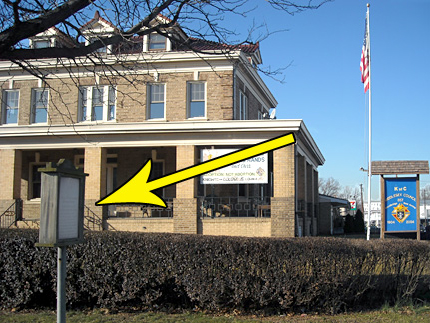

Original Site of the Cross Keys Tavern
130 Main St.
Map / Directions to the Original Site of the Cross Keys Tavern
Map Directions to all Woodbridge Revolutionary War Sites
A short walk from the Cross Keys Tavern is the site where it originally stood before it was moved in the 1920's. In front of the Knights of Columbus is a sign explaining the historic significance. (Pointed out in the above photo with the Yellow Arrow).
The sign reads, "George Washington's Inauguration - on this site stood the historic Cross Keys Tavern where George Washington and his party including Governor Livingston arrived late afternoon Saturday April 22, 1789 to spend the night before proceeding to Elizabethtown and hence to New York where he was inaugurated the first President April 30, 1789. The tavern was later moved to a location on James Street." [11]
The chimney on the Knights of Columbus building was originally part of the Cross Keys Tavern building.

1. ^ William Beatty, Transcribed and Annotated by John Beakes, The Papers of Captain William Beatty, of the Maryland Line (Printed from the original manuscripts in the Maryland Historical Society, 1866) p.3. Available to be read at the Internet Archive here
▸ Captain Beatty, who was part of the army as it retreated across New Jersey in November 1776, described the move from Newark to New Brunswick as follows. (Beatty's original spelling, spacing, and capitalization have been left uncorrected in this excerpt.)"From New ark Our army retreated in two Collums One by the Way of Wood bridge to Brunswick & the Other by the New-ark mountain Springfields, Scotch-Plains Quibbletown & to Brunswick." (Quibbletown was part of Piscataway.)
• Even though the historic sign states that Washington came through Woodbridge on November 28-29, it seems unclear to me which of the two paths Washington himself followed, which is why the entry states that Washington's army moved through Woodbridge.
• The historic sign was erected by the New Jersey Commission on Historic Sites
2. ^Rev. Joseph W. Dally, Woodbridge and Vicinity: the Story of a New Jersey Township (New Brunswick: A. E. Gordon, 1873) p. 228 Available to be read at the Internet Archive here
3. ^ Information about the church buildings and Freeman as its architect are drawn from the Church History page of the church's website. For those who might be interested in a few more details about the church structure, the Church History page also provides additional information about renovations to the church's appearance, as well as images of church buildings through the years..
• Freeman's grave in the cemetery has a marker which reads, "Architect and builder of the First Presbyterian Church 1803 / Revolutionary War Soldier / Church Trustee 1802-1809."
If you are looking to find Freeman's gravesite: it is located just behind the church, over to the right, near the corner formed by the church and the church annex.4. ^ Names, dates, and rank information is drawn from gravestones and markers in the cemetery, and from church records.
Information from church records was provided to me by Suzanne Moller of the First Presbyterian Church of Woodbridge in an email correspondence in April and May 2013.
Suzanne was very helpful, and generous with her time. I thank her for her help.
5. ^ Information about the history of the Trinity Episcopal Church was drawn from two sources:
• The church's website
• Township of Woodbridge, Inventory of Historic Sites, Compiled by the Woodbridge Township Historic Preservation Commission, January 2013. pg. 706. ^ Asher Dunham information obtained from the modern marker at his gravesite.
7. ^ Township of Woodbridge, Inventory of Historic Sites, Compiled by the Woodbridge Township Historic Preservation Commission, January 2013. pg. 71
8. ^ Township of Woodbridge, Inventory of Historic Sites, Compiled by the Woodbridge Township Historic Preservation Commission, January 2013. pg. 61
9. ^ Information about the history of the Aaron Dunn house in this entry, including the quote about the architecture in the second paragraph, was drawn from:
• Township of Woodbridge, Inventory of Historic Sites, Compiled by the Woodbridge Township Historic Preservation Commission, January 2013. pg. 6910. ^ Information about the history of the Cross Keys Tavern in this entry was drawn from:
Township of Woodbridge, Inventory of Historic Sites, Compiled by the Woodbridge Township Historic Preservation Commission, January 2013. pg. 14• For more information and accompanying source notes for Washington's 1789 inaugural trip and Lafayette's 1824/1825 visit to America, see the individual town pages linked within this entry's text.
11. ^ Historic sign is marked 'Woodbridge', and 'WE THE PEOPLE UNITED STATES CONSTITUTION 1787-1791 BICENTENNIAL 1987-1991'